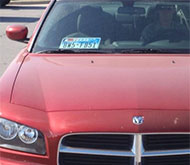10/28/2021
2002 Montana Supreme Court Ruling Allows License Plates In WindowsA ruling from 2002 gave Montana residents the right to place front license plates in the front window of their car.

By Richard Diamond
Ohio lawmakers last year dropped the requirement for cars to have front license plates, joining twenty other states that have rejected the requirement. In the rest of the country, police frequently use the lack of a front plate as justification for investigatory stops and searches. Owners of cars that lack a suitable mounting place sometimes place their plate in the front window. In a 2002 ruling, the Montana Supreme Court upheld the practice as entirely legal.
On February 18, 2001, Gary Lacasella had been driving his red Ford pickup truck on Highway 93 when Missoula County Sheriff's Deputy Michael Dominick decided to pull him over because the truck's license plate was not attached to the front bumper. Lacasella had securely attached it to the front left corner of his windshield with duct tape. A lower court ruled that the traffic stop was justified because the front windshield was not the "front" of the truck, and glare might have made the plate unreadable at night. The high court majority disagreed with this analysis.
As in most states with a front plate law, Montana requires license plates to be "conspicuously displayed, one on the front and one on the rear of the vehicle, each securely fastened to prevent it from swinging and unobstructed from plain view." The court rejected the idea that the front windshield does not count as the front of the car.
"Common sense indicates that such a narrow definition of front in this context makes conduct that complies with the purpose of the statute illegal," Justice Terry N. Trieweiler wrote for the Supreme Court majority. "The law simply requires that license plates be visible from both the front and the rear of a vehicle. The photographs of Lacasella's vehicle demonstrate that his license plate was visible from the 'front' of the vehicle and could be seen by an approaching vehicle."
The justiced also rejected the lower court's argument that the plate's location was impermissible because of the possibility of glare.
"There is no evidence that the plate was obscured by glare on the night in question," Justice Trieweiler wrote. "Although a court is permitted to make reasonable inferences from the facts, it is not permitted to assume facts not in evidence. Therefore, we conclude that Lacasella's license plate was clearly and conspicuously displayed and unobstructed from plain view."
Because the justices found the deputy had no legitimate reason to pull Lacasella over in the first place, the court suppressed the evidence that he had been driving under the influence. A copy of the ruling is available in a 70k PDF file at the source link below.


